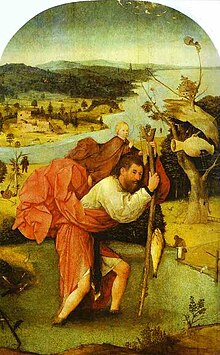
Back Sint Christopher Afrikaans كريستوفور (قديس) Arabic متياس كريستوفر ARZ Müqəddəs Xristofor Azerbaijani Святы Хрыстафор Byelorussian Сьвяты Хрыстафор BE-X-OLD Свети Христофор Bulgarian Sant Kristof Breton Cristòfor de Lícia Catalan Svatý Kryštof Czech
Christopher | |
|---|---|
 St. Christopher Carrying the Christ Child, by Hieronymus Bosch (AD 1485) | |
| Martyr | |
| Born | Unknown Canaan (Western accounts) or Marmarica (Eastern account) |
| Died | 251 Anatolia |
| Venerated in | |
| Canonized | Pre-Congregation |
| Feast |
|
| Attributes | tree, branch, as a giant or ogre, carrying the Christ child, spear, shield, as a dog-headed man |
| Patronage | athletics, bachelors, transportation (drivers, sailors, etc.), traveling (especially for long journeys), surfing, storms, Brunswick, Saint Christopher's Island (Saint Kitts), Island of Rab, Vilnius, Havana, epilepsy, gardeners, toothache |
Saint Christopher (Greek: Ἅγιος Χριστόφορος, Hágios Christóphoros, lit. 'Christ-bearer';[3] Latin: Sanctus Christophorus) is venerated by several Christian denominations as a martyr killed in the reign of the 3rd-century Roman emperor Decius (r. 249–251), or alternatively under the emperor Maximinus Daia (r. 308–313). There appears to be confusion due to the similarity in names "Decius" and "Daia".[4] Churches and monasteries were named after him by the 7th century.
His most famous legend tells that he carried a child, who was unknown to him, across a river before the child revealed himself as Christ. Therefore, he is the patron saint of travelers, and small images of him are often worn around the neck, on a bracelet, carried in a pocket, or placed in vehicles by Christians.
- ^ (in Greek) Ὁ Ἅγιος Χριστοφόρος ὁ Μεγαλομάρτυρας. 9 Μαΐου. ΜΕΓΑΣ ΣΥΝΑΞΑΡΙΣΤΗΣ.
- ^ "الشهيد خريستوفوروس حامل المسيح". St-Takla.org. Retrieved 5 August 2022.
- ^ Godden, Richard H.; Mittman, Asa Simon (21 November 2019). Monstrosity, Disability, and the Posthuman in the Medieval and Early Modern World. Springer Nature. p. 183. ISBN 978-3-030-25458-2.
- ^ T.D. Barnes, The New Empire of Diocletian and Constantine (Cambridge, MA, 1982). pp. 65–66.
© MMXXIII Rich X Search. We shall prevail. All rights reserved. Rich X Search